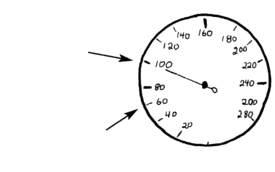Hesperian Health Guides
Check the mother’s body
Contents
- 1 Check for signs of diabetes
- 2 Check for signs of anemia
- 3 Check for signs of poor nutrition or lack of iodine
- 4 Weigh the mother
- 5 Check the mother's temperature
- 6 Check the mother's pulse
- 7 Check the mother's blood pressure
- 8 Check for signs of pre-eclampsia (toxemia of pregnancy)
- 9 Check for sexually transmitted infections (STIs)
- 10 Check for signs of bladder or kidney infection
Check for signs of diabetes
If a woman has some of the following warning signs, she may have diabetes. Women with diabetes do not always have all of these signs.

- She is thirsty all the time.
- She has frequent yeast infections.
- Her wounds heal slowly.
- She has to urinate more often than other pregnant women.
- Her womb is bigger than expected for how many months she has been pregnant.
When a woman has diabetes, her body cannot use the sugar in her blood. Your local health department may be able to give a blood test for diabetes. The best time to do this test is at about 6 months (24 weeks) of pregnancy.
Diabetes can make a woman very sick and childbirth more dangerous. Women with diabetes are at high risk for pre-eclampsia. Her baby may be very big, or it may become very ill and die after the birth.
How to help a woman with diabetes
Usually diabetes in pregnancy will improve if the woman gets physical activity, eats a variety of nutritious foods, and eats frequent small meals. A woman with diabetes should get medical help, may need medicine to prevent serious problems, and should probably plan to have her baby in a medical center.
For more information about diabetes, see Hesperian's booklet Diabetes, the NEW Where There Is No Doctor, or another general health book.
Check for signs of anemia

General good health and plenty of energy.
- Pale inside of eyelids, fingernails, and gums.
- Dizziness or fainting.
- Weakness or tiredness.
- Fast pulse (over 100 beats a minute).
- Difficulty breathing.
There is also a blood test for anemia.
When someone has anemia, it usually means she has not been able to eat enough foods with iron. Iron helps the blood carry oxygen from the air we breathe to all parts of the body. Some kinds of anemia are caused by illness, not lack of iron. And some kinds of anemia are inherited (genetic). They cannot be cured by eating iron foods or iron pills.
Many pregnant women have anemia, especially poor women. Women with anemia have less strength for childbirth and are more likely to bleed heavily, become ill after childbirth, or even die.

How to treat anemia
Ordinary anemia can usually be cured by eating foods high in iron (like beans, yams and meat) and foods high in vitamin C (like citrus fruits and tomatoes), and by taking iron supplements. After using these methods, the mother should be checked again in about 4 weeks. If she is not getting better, get medical advice. She may have an illness, or she may just need a stronger iron supplement.
| To treat anemia with iron supplements |  | |
| ||
If a woman is very anemic in the 9th month of pregnancy, she should plan to have her baby in a medical center.
Check for signs of poor nutrition or lack of iodine
General good health and a lot of energy.

Signs of general poor nutrition:
- Not wanting to eat.
- Not gaining weight.
- Weakness and general ill health.
- Sores, rashes, or other skin problems.
- Sore or bleeding gums.
- Stomach problems or diarrhea.
- Burning or numbness of the feet.

Signs of lack of iodine:
- Goiter (swelling in the front of the throat).
- Short children, or children with deafness or hypothyroidism, a disability that affects thinking.
What to do for poor nutrition
The best way to prevent or cure poor nutrition is to help people eat well. Find out what the mother has been eating. See ways to help her eat better. Remember: vitamin pills and tonics can be helpful in pregnancy, but they cannot replace a good diet!

A woman with poor nutrition is more likely to have a difficult birth, a too-small baby, and more difficulty recovering from birth. If you are worried that a woman may have a hard birth because of poor nutrition, get medical advice.

Weigh the mother
Mother slowly and steadily gains between 9 and 18 kilograms (20 to 40 pounds) during pregnancy. This is the same as 1 to 2 kilograms (2 to 4 pounds) each month.
- Mother is very thin or gains fewer than 9 kilograms (20 pounds) during pregnancy.
- Mother gains more than 19 kilograms (42 pounds) during pregnancy.
- Mother gains weight suddenly — more than 2 kilograms (4 pounds) in 1 week or 4 kilograms (8 pounds) in 1 month, especially in the last 2 months of pregnancy.
Most of the weight a woman gains during pregnancy is from her baby, the placenta, and the bag of waters. The mother also puts on some fat. This is healthy.
Weigh the mother at each visit. If possible, always use the same scale.
What to do if you find warning signs
Mother does not gain enough weight
Some women are small or thin and may stay small or thin during pregnancy without this being a problem. But all pregnant women should steadily gain weight. If the mother does not gain weight as expected (see above), try to find out why. Ask the mother about:
- her eating.
- hookworm and other parasites.
- drug use.
- nausea and vomiting.
- HIV.
- money problems (cannot afford food).
Mother gains more weight than recommended
Women of all sizes can be healthy and have safe births Gaining more weight than expected, especially early in pregnancy, can be a warning sign of diabetes.
Mother gains weight suddenly
If a mother gains weight suddenly near the end of her pregnancy, it may be a sign of twins or pre-eclampsia.
Check the mother's temperature
Temperature is close to 37°C (98.6°F). Woman does not feel hot-to-touch.
Woman has a fever — a temperature of 38°C (100.4°F) or above. Woman feels hot-to-touch.

How to check the temperature
If you do not have a thermometer, put the back of one hand on the woman’s forehead, and the other on your own or that of another healthy person. If the woman has a fever, you should be able to feel that her skin is hotter than that of a healthy person.
If you have a thermometer, clean it well with soap and clean water or alcohol. To use it, press the button to turn it on.

If you have a thermometer, you can use it to take a person's temperature in the mouth, armpit, or rectum. The temperatures shown here are for temperatures taken in the mouth.
| digital thermometer |
Glass thermometers may be filled with mercury, a poisonous liquid metal. If you can, get a digital thermometer, or a glass thermometer filled with alcohol. If a mercury thermometer breaks, do not pick up the silver mercury with your bare hands. Sweep the mercury into a jar and bury it. Do not let children play with thermometers or mercury.
To use the thermometer
- Clean the thermometer with soap and cold water, or alcohol. For a digital thermometer, push the button to turn it on. For a glass thermometer, hold it at the end without the silver or red and shake it hard, with a snap of the wrist, until it reads less than 36°C (96°F).
- Put the thermometer under the tongue (woman should keep her mouth closed).
- Leave it there 3 to 4 minutes. The digital thermometer will "beep" when it is ready.
- Always clean the thermometer with soap and cold water, or alcohol, after you use it.
What to do if the woman has a fever

A fever can be caused by:
- sickness — like flu or malaria.
- an infection of part of the body — like a bladder infection or a womb infection.
A mild fever can also be caused by dehydration.
Find the cause of the fever, and then treat it. Along with treating the cause, a high fever needs to be lowered right away.
| To lower a fever |  | |||
|
by mouth, every 4 to 6 hours as needed (do not take more than 4000 mg in a day) | |||
|
And have her drink 1 cup of water or rehydration drink every hour. If she is too sick to drink, give
rectal fluids or IV fluids.
| ||||
Check the mother's pulse
Pulse is about 60 to 80 beats a minute when the mother is resting.
Pulse is 100 beats a minute or more when the mother is resting.
The pulse tells you how fast the heart is beating. Everyone’s pulse is different.
How to check the pulse
 |
 |
| You can find the pulse on the side of the throat, under the corner of the jaw... | or on the wrist below the thumb. |
- Wait until the mother is resting and relaxed.
- Put the pads of two fingers on the pulse. Do not use your thumbs.
- Count the number of beats in a minute.

How to know how long to count:
- If you have a watch with a second hand, or a digital watch, or a phone with a clock on it, count the number of beats in the mother’s pulse for 1 minute.
(At first, have someone watch the clock for you and tell you when to start and stop counting. Many people find it hard to count accurately while looking at a watch. They tend to count one pulse beat every second, no matter how fast the pulse is really beating.) - If you do not have a watch with a second hand, check the pulse anyway. You can learn to tell if it is slow or fast compared to your own pulse, and to other women’s. Or you can make a homemade timer to use instead of a watch.
What to do if the woman has a fast pulse
If the mother's pulse is 100 beats a minute or more, she may have one or more of the following problems:

- stress, fear, worry, or depression. See also about giving emotional support after birth.
- anemia
- infection like malaria, bladder infection, or womb infection
- heavy bleeding
- dehydration
- harmful drugs in her blood (for example, from using cocaine or methamphetamines or taking diet pills)
- thyroid trouble
- heart trouble
If you suspect any of these causes, click on the link for more information. If you do not know what is causing the fast pulse, get medical advice.
Check the mother's blood pressure
Blood pressure stays between 90/60 and 140/90 and does not go up much during pregnancy.
High blood pressure. The mother has high blood pressure if either of these is true:
- The top number is over 140.
- The bottom number is over 90.
(Very low blood pressure is also a warning sign, but is usually only caused by heavy bleeding or shock.)
A woman’s heart pumps her blood through her body. High blood pressure means that the heart must work harder to press the blood through tight or shrunken blood vessels (veins and arteries).
High blood pressure during pregnancy makes it harder for the mother's blood to bring food to the baby, so the baby grows too slowly. Very high blood pressure may cause the mother to have kidney problems, bleeding in the womb before birth, or bleeding in the brain.
High blood pressure can also be a sign of pre-eclampsia. Pre-eclampsia can lead to premature birth, bleeding, convulsions, and even death for the mother or baby.
For these reasons it is very important to check the mother’s blood pressure.
How to check blood pressure
There are several types of blood pressure equipment.
| Some have a tall gauge that looks like a thermometer. | Others have a round dial. | Others use electricity to self-inflate and have an electronic screen. |
 gauge
bulb
cuff
|
 dial
cuff
bulb
|
 |
When you take the mother’s blood pressure, first tell her what you are going to do and why, and make her as comfortable and relaxed as possible. To avoid errors, the mother should not exercise or drink coffee for 30 minutes, and should sit at rest for 5 minutes, before you measure her blood pressure.
Have the mother sit with her feet flat on the ground. The elbow of the arm you will be measuring from should be at the same level as her heart.
| 1. Fasten the cuff around the bare upper arm about 2 finger widths above the elbow crease. | 2. Close the valve on the rubber bulb by turning the screw to the right. The screw will get shorter. | |
 |
 |
|
| 3. Feel for a pulse just below the cuff, on the inside of the elbow. Put the stethoscope over the pulse and put the ear pieces in your ears. | 4. Pump the cuff up by squeezing the bulb. | |
 |
 |
| 5. As you pump, the needle will move. When it reaches 200, stop pumping. | 6. Then open the valve just a little so that the air leaks out slowly. | 7. The needle will begin to go back down. (If the valve is closed, it will stay at 200.) | ||
 |
 |
 |
| 8. As the air leaks out, you will start to hear the mother's pulse through your stethoscope.
Notice where the needle or mercury is:
1. when you start to hear the pulse (this will be the top number), and
2. when the pulse disappears or gets very soft (this will be the bottom number)
|
 If you start to hear a pulse here
and then cannot hear it anymore when the needle is here
then the blood pressure is: 100/60 | |||

Check the mother’s blood pressure at each visit. Keep a record, so you can look for changes over time.
If her blood pressure is going up, ask her to come back every week until you are sure that it is not still rising.
If it is ever higher than 140/90, then the blood pressure is too high and can be a warning sign.
If her blood pressure is 140/90 or higher
If the mother’s blood pressure is high the first time you take it, have her lie on her left side. Help her relax (stress or fear can cause blood pressure to go up). In 10 to 30 minutes, take her blood pressure again.
- If the blood pressure goes down below 140/90, things are probably OK. If possible, have the mother come back in a few days so you can take her blood pressure again. Ask her to rest on her side every day.
- If the blood pressure does not go down, there may be a problem. Take her blood pressure later that day, or the next day, and if the blood pressure stays high, get medical advice. Teach the mother the danger signs of pre-eclampsia and check if she has any of those signs. If she has these signs, get medical help fast. It will probably be safest for her to give birth in a medical center.
- If the top number of the blood pressure is over 150, or if the bottom number is over 100, get medical help now. She may be able to take medicines to control her blood pressure until the birth.
Home care for moderately high blood pressure (between 140/90 and 150/100)
If possible, a pregnant woman with moderately high blood pressure should see a health worker who can prescribe medicine to lower her blood pressure, such as methyldopa (250 mg by mouth, 2 to 3 times a day). She needs to:

- Rest often during the day. She should rest as much as she can, even if it is just for several minutes every hour. When in bed, it is best if she rests on her left side. It is especially important to rest in the last 3 months of pregnancy.
- Eat a good diet. Help the woman eat a variety of vegetables, fruits, and protein. Foods high in protein, calcium, or magnesium all may help prevent pre-eclampsia. Eating cucumbers, beets, bananas, or lemon or lime juice might help lower blood pressure.

- Drink a lot of liquid. Have the woman drink plenty of clean water, herb teas, soups, or other healthy fluids.
- Avoid very salty foods. A little salt is fine, but women with high blood pressure should avoid foods with a lot of salt like potato chips, salted nuts, or processed meats.
Check for signs of pre-eclampsia (toxemia of pregnancy)
Pre-eclampsia is a very dangerous problem that can happen in late pregnancy, during labor, or in the few days after a woman has a baby. It can lead to convulsions (eclampsia) and even death.
Blood pressure is below 140/90 while at rest
The 2 most sure signs of pre-eclampsia are:
- high blood pressure (140/90 or higher) and
- protein in the urine.
If a woman has both of these signs, she already has pre-eclampsia and needs medical help right away.
If she has high blood pressure and any of these danger signs, she probably has pre-eclampsia — and you should get medical help:

- Strong headaches.
- Vision changes such as spots, blurriness, or double vision.
- Steady, severe pain in the top of the belly or the right side just under the ribs. If it feels like acid indigestion, you can give an antacid. If the pain does not get better in 20 minutes, it is a danger sign.
- Overactive reflexes. To check the foot for overactive reflexes:
 |
 |
| Have the woman lie down and hold her foot like this. Give a sharp push, then let go. | If the foot jerks 2 times or more, it is a danger sign. |
Get medical help immediately if you also see any of these signs:
- Baby seems too small when you measure her womb. This might mean the the baby's growth is too slow.
- She is drinking enough liquid but making only a little urine.
- Trouble breathing, or wet-sounding lungs.
Other warning signs of pre-eclampsia:
- swelling of the face and hands (especially if she has the swelling when she first wakes up in the morning).
- sudden weight gain.
If she has these signs, continue to check her regularly.
Checking for pre-eclampsia

1. Check the woman's blood pressure.
High blood pressure is always a warning sign.
2. If possible, check for protein in the urine.
There are 2 methods for doing this.
Method 1: Use small plastic strips called Uristix, Albustix, or Labstix to check for protein. Check the date on the box to make sure they are not expired.

You may be able to get a bottle of these sticks from the local health authority or pharmacy. The strips have different squares that change color depending on what is in a person’s urine. Ask the mother to urinate into a clean container. Dip the squares on the stick into the urine for a few seconds, then remove and compare the color of the squares with the color chart on the bottle. If the square for protein turns dark green, there is protein in the urine. This is the most accurate way to check for protein.
Method 2: Heat the mother's urine to check for protein.

Ask the mother to wash her genitals well and then urinate into a clean container. Then pour the urine into a test tube to within 2½ centimeters (or one inch) of the top of the tube. Heat the upper part of the tube over a small burner, low flame, or candle until the urine boils. (Keep turning the test tube or the glass will break.)
If the urine is clear, there is no protein in it. If the urine becomes cloudy and white, add a few drops of vinegar (2% acetic acid). If the cloudiness goes away there is no protein in the urine. If it stays cloudy or gets whiter, there is protein in the urine. If the woman has protein and high blood pressure, she has pre-eclampsia. When a woman has severe pre-eclampsia, the urine may become very cloudy, white, and thick.

Method 3: Ask the mother if she has had any headaches, dizziness, or trouble seeing.
If these problems are severe or happen often, especially if they start in the last 3 months of pregnancy, they can be signs of pre-eclampsia.
Method 4: Check for swelling. Swelling is also called water weight, water retention, or edema.

Swelling is common during pregnancy. It is not usually a serious warning sign, especially swelling on the ankles and feet which goes away after the woman rests with her feet up. If the woman is having swelling, she should drink plenty of water, take more breaks during the day, and put her feet up when she can.
Swelling can be a sign of pre-eclampsia if:
- the woman’s hands or face are puffy or swollen and
- the woman has swelling when she first wakes up in the morning
What to do if you find warning signs
If a mother has warning signs, get medical help (even if the birth is several months away). It may be safer for her to give birth in a medical center. If you must do the birth at home, be prepared for problems. Read the sections on bleeding, convulsions, and small babies.
Taking a low dose of aspirin (81 mg) may prevent pre-eclampsia. If the mother is told to rest at home, encourage her to follow the instructions for home care for high blood pressure.
Check for sexually transmitted infections (STIs)
Some sexually transmitted infections (STIs) can be passed from the mother during pregnancy or birth and harm the baby. Check for these STIs during pregnancy, even if there are no signs. Treat STIs as soon as possible.
- See about testing and treatment of chlamydia and gonorrhea.
- See about testing and treatment of syphilis.
- See about testing and treatment of HIV.
Check for signs of bladder or kidney infection

The kidneys, kidney tubes, bladder, and urethra (where urine comes out of the body) work together to get rid of body wastes. First the kidneys clean the blood and turn waste into urine. Then the urine goes down the kidney tubes to the bladder, where it stays until you urinate.
Harmful germs can get into the urethra and an infection can easily spread to the bladder or kidneys.
Infections of the urine system are more common during pregnancy. Without treatment, they can be dangerous for the mother and can cause early labor.
No pain, itching, or burning when urinating.

Signs of bladder infection
- constant feeling of needing to urinate, even after having just urinated
- pain or burning during or just after urinating
- pain in the lower belly, behind the front of the pelvis
- urine smells strong, looks cloudy, or has blood in it
Signs of kidney infection
- any signs of bladder infection
- nausea and vomiting
- fever and chills
- feeling very sick or weak
- pain, often severe, that begins in the lower back and can spread to the front and sides of the body
What to do for signs of bladder infection
Encourage the mother to drink 1 glass of liquid every hour while she is awake. Passing urine more often helps wash germs and infection out of the body. Encourage the mother to eat fruits that have a lot of vitamin C, like oranges, guavas, kiwis, mangos, or jujubes.
Use local plant medicines that fight infection or heal injured tissues, such as:

- corn silk tea — boil a large handful of the tassels from ears of corn (maize) in water, and drink 1 or 2 cups.
- marshmallow tea — soak chopped pieces of the root of the marshmallow plant (Althaea officinalis) in cold water overnight and then drink.
If the infection does not improve quickly, or there are any signs of kidney infection, give antibiotics. Do not wait or the infection will be more difficult to treat.
See the Medicines Pages before giving any medicine.
| To treat a bladder infection |  | |||||
|
by mouth, 2 times a day for 5 days | |||||
| OR | ||||||
|
by mouth, 2 times a day for 3 days | |||||
| OR | ||||||
|
by mouth, 3 times a day for 7 days | |||||
| Do not give nitrofurantoin during the last month of pregnancy or the first month after birth if breastfeeding | ||||||
| To treat a kidney infection |  | |||||
|
in the muscle, one time only | |||||
| AND | ||||||
|
by mouth, 2 times a day for 14 day | |||||
| OR | ||||||
|
by mouth, 2 times a day for 14 day | |||||
| If she is not better after 2 days of antibiotics, get medical help. | ||||||

Prevent bladder infections
Teach women how to keep germs in stool away from the urethra by wiping from front to back after urinating or passing stool. Remind women’s partners to clean their hands and genitals before sex. Women should also urinate right after having sex.




